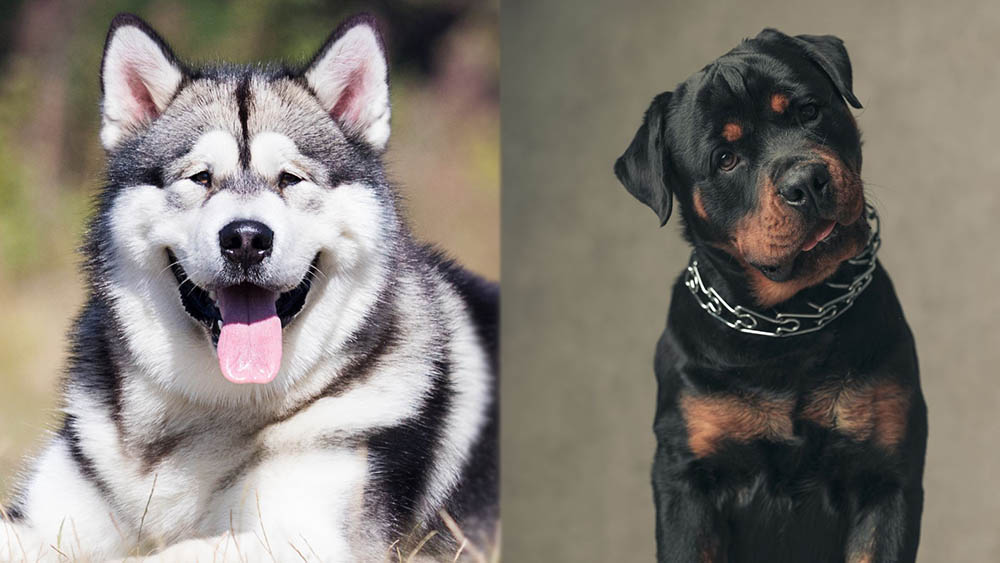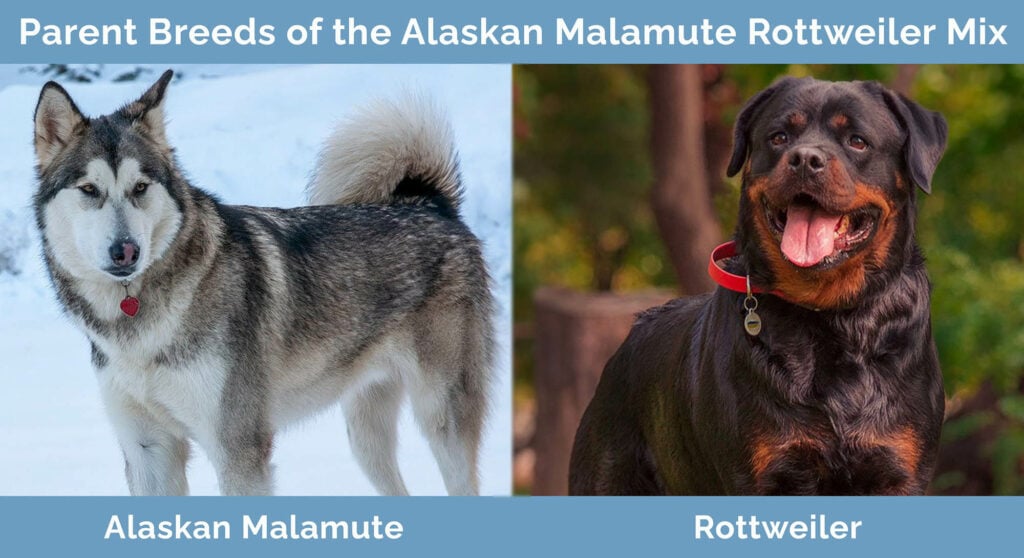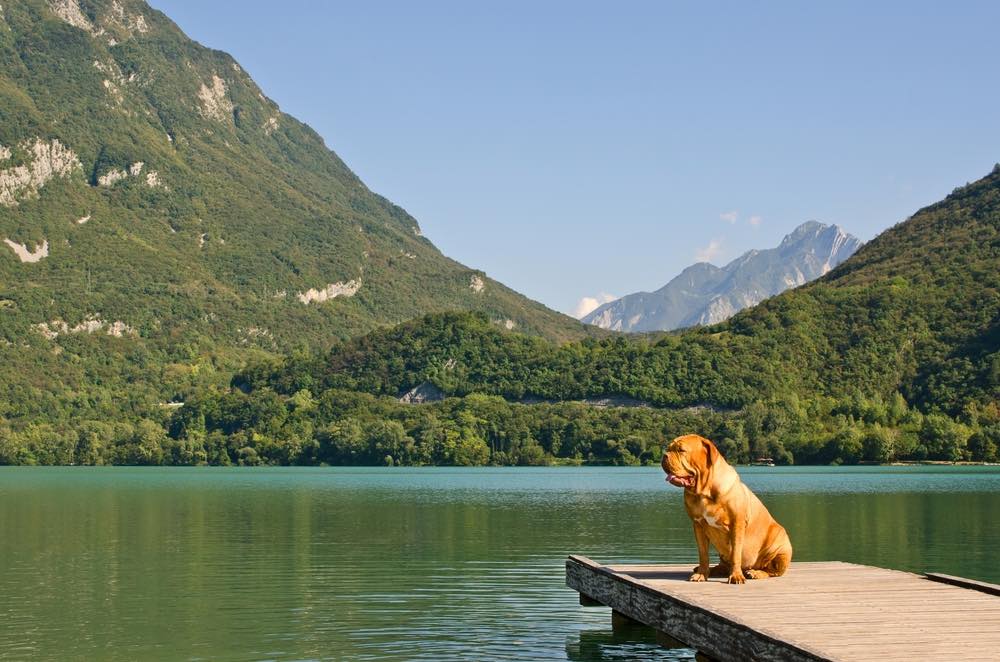Alaskan Malamute Rottweiler Mix: Care, Pictures, Traits & Characteristics
By Jessica Kim
Updated on

Alaskan Malamute Rottweilers are a relatively uncommon mixed dog breed. There’s still much to discover and learn about them, but we can get a good picture of what they’re like because of the abundance of information about Alaskan Malamutes and Rottweilers.
In general, Alaskan Malamute Rottweilers are large dogs that are extremely loyal and affectionate with their families. Despite having the potential to become wonderful family dogs, Alaskan Malamute Rottweilers are recommended for experienced dog owners because they can be challenging when it comes to training.
There’s a lot that prospective dog owners must know about Alaskan Malamute Rottweilers before deciding to bring one home. Here’s what you need to know about these dogs and if they’re the right breed for you.
Breed Overview
| Height: | 12–18 inches |
| Weight: | 75–130 pounds |
| Lifespan: | 8–15 years |
| Colors: | White, blue, silver, red, brown, gray, black |
| Suitable for: | Active families, families with older children, experienced dog owners |
| Temperament: | Affectionate, loyal, playful, intelligent |
Alaskan Malamute Rottweilers are playful and affectionate pets. They’re high-energy dogs that are sure to bring a lot more excitement to life. Their bravery and love for adventure often make them excellent companions for people with active lifestyles. Alaskan Malamute Rottweilers would love nothing more than to spend all day with their families and go on outdoor excursions with them.
Alaskan Malamute Rottweiler Characteristics
Alaskan Malamute Rottweiler Puppies
It can be difficult to find breeders that specifically breed Alaskan Malamute Rottweiler puppies. So, you might have better luck finding one at a dog adoption center. Alaskan Malamute Rottweiler puppies are certainly adorable, but they’re also a handful. Prospective owners must be realistic about living with these puppies because of their high energy and large size.
Alaskan Malamute Rottweiler puppies are curious, so it’s important to puppy-proof your entire home, or else they can get themselves into unsafe situations. They’ll benefit from crate training, which will help keep them safe when you can’t give them your undivided attention. They’ll also need multiple play sessions throughout the day to prevent boredom and expend their energy.

Temperament & Intelligence of the Alaskan Malamute Rottweiler
Alaskan Malamute Rottweilers are known for their loyalty and intelligence. They can be aloof with strangers, but they’re shameless with the affection they show to their families. While they are family dogs, they’re also fairly independent thinkers. So, it can be extra challenging to train them, especially in the beginning stages. It can take longer to convince them to follow obedience commands, and it’s often beneficial to enlist the help of a professional dog trainer to set up a strong foundation for an Alaskan Malamute Rottweiler.
Once an Alaskan Malamute Rottweiler gets a good grasp on obedience training, you’ll find that they’re quick learners. Alaskan Malamutes have the personality and body type to be excellent working dogs. They can become very capable service dogs and good candidates for police, military, and search and rescue work.
Are These Dogs Good for Families? 👪
Alaskan Malamute Rottweilers are extremely loyal family dogs. They’re known to be affectionate and playful with their family members. However, they must learn how to interact appropriately and safely with young children. They’re not likely to show aggression to children, but they can accidentally knock them over when they’re playing or feeling excited. Therefore, Alaskan Malamute Rottweilers are often recommended for families with older children.
Does This Breed Get Along With Other Pets?
Early socialization is key with Alaskan Malamute Rottweilers. They can have a protective side to them and may develop resource-guarding habits. So, it’s important to socialize them and prevent them from developing this behavior.
Alaskan Malamute Rottweilers tend to have a strong prey drive, so it’s not recommended to keep them with other pets that aren’t dogs. Some can learn to coexist peacefully with cats, but they usually can’t be left unsupervised with other types of pets.
Things to Know When Owning an Alaskan Malamute Rottweiler
Food & Diet Requirements 🦴
Alaskan Malamute Rottweilers are large dogs that will benefit from eating dog food that’s specifically formulated for large dog breeds. Dogs of different sizes have distinct dietary needs. In general, puppies of large dog breeds must avoid excessive growth and overnutrition. So, it’s important to find puppy food with formulas that contain lower amounts of fat, calcium, phosphorus, and vitamin D.
Adult Alaskan Malamute Rottweilers should continue to eat dog food formulated for large breeds. This will help reduce the risk of orthopedic disease, obesity, and bloat.
Exercise 🐕
Both Alaskan Malamutes and Rottweilers are energetic dogs that have a lot of stamina. They require at least an hour of daily exercise. Alaskan Malamute Rottweilers will enjoy going on daily walks, but they’ll love being able to run around off-leash in a fully fenced yard.
Along with physical exercise, Alaskan Malamute Rottweilers require plenty of mental exercises. They’re highly intelligent and need enrichment activities to prevent boredom. Some ways you can add mental challenges to your Alaskan Malamute Rottweiler’s daily routine is introducing them to treat dispensing toys or dog puzzles. They may also enjoy participating in canine sports like agility courses.
Training 🎾
Alaskan Malamute Rottweilers are highly intelligent dogs, but they can still be challenging to train because they tend to be independent. It can be difficult to engage them in formal training sessions, so they’re often recommended for experienced dog owners who have the time to invest in consistent and fair training.
Training typically becomes easier with time as their bond strengthens with their owners. Alaskan Malamute Rottweilers do best with owners who can provide firm and fair training and usually respond better to short and frequent training sessions scheduled throughout the day.
Grooming ✂️
Grooming an Alaskan Malamute Rottweiler will depend on their coat type. Dogs with coats more closely related to an Alaskan Malamute will require regular brushing, especially during their shedding season. This will help to minimize shedding around the house.
Rottweilers have shorter, low-maintenance coats. So, if your Alaskan Malamute Rottweiler has a shorter coat, you can probably get by with weekly brushing with a bristle brush.
Health and Conditions 🏥
Alaskan Malamute Rottweilers are generally healthy, but they’re susceptible to some genetic conditions. Certain health issues may arise as they age. Here are a few health conditions that are commonly known to affect Alaskan Malamute Rottweilers.
- Hip dysplasia
- Hypothyroidism
- Von Willebrand disease
- Cancer
- Heart disease
- Bloat
Male vs Female
There aren’t any concrete differences between male and female Alaskan Malamute Rottweilers other than size. Male Alaskan Malamute Rottweilers are often larger and heavier than females. Since they’re a relatively new mixed breed, Alaskan Malamute Rottweilers can have varying temperaments. So, differences in personality often have to do with the breed as a whole rather than the dog’s sex.
3 Little-Known Facts About the Alaskan Malamute Rottweiler
1. Alaskan Malamutes and Rottweilers come from a line of ancient dog breeds.
Both Alaskan Malamutes and Rottweilers have lineages that trace back to ancient times. Alaskan Malamutes are amongst the oldest sled dog breeds, and their ancestry traces back to Paleolithic Arctic wolfdogs. Rottweilers are known to have German origins. However, their foundation stock can be traced back to ancient dog breeds that lived during the Roman Empire.
2. Alaskan Malamute Rottweilers are excellent working dogs.
Alaskan Malamute Rottweilers are strong, have a lot of stamina, and like being entrusted with responsibilities. These traits make them excellent working dogs, and they can excel in various fields. They can be search and rescue dogs or police dogs and can also help many different kinds of people who are in need of a service dog.
3. Alaskan Malamute Rottweilers are indoor dogs.
Despite their large size and tendency to grow a thick coat, Alaskan Malamute Rottweilers are family dogs that must live indoors with their families. They develop strong bonds with people and prefer to be with their pack. So, they shouldn’t be left outdoors and unsupervised for too long.
Keep in mind that Alaskan Malamute Rottweilers tend to shed a lot, especially during their shedding seasons. So, it’s important to stay on top of brushing and grooming to minimize the amount of loose hair on your clothes, carpets, and furniture.
Final Thoughts
Alaskan Malamute Rottweilers can become wonderful family dogs. They’re affectionate, loyal, and protective of their loved ones. However, they can be a little difficult to train due to their independent natures. Alaskan Malamute Rottweiler owners must be prepared to spend a significant amount of time and energy on training and exercise. These dogs do best with people with active lifestyles and will love being able to accompany them everywhere they go. They’re one of the best travel companions for your next outdoor adventure.
See Also:
- Alaskan Malamute Corgi Mix: Care, Pictures, Traits & More
- Alaskan Malador: Care, Pictures, Traits & Characteristics
Featured Image Credit: (L) Happy monkey, Shutterstock | (R) Viorel Sima, Shutterstock














